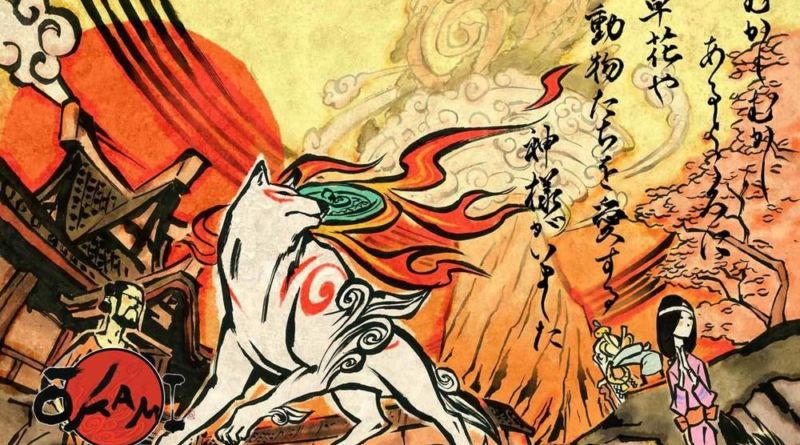Ōkami, First Scroll – Tales and Legends
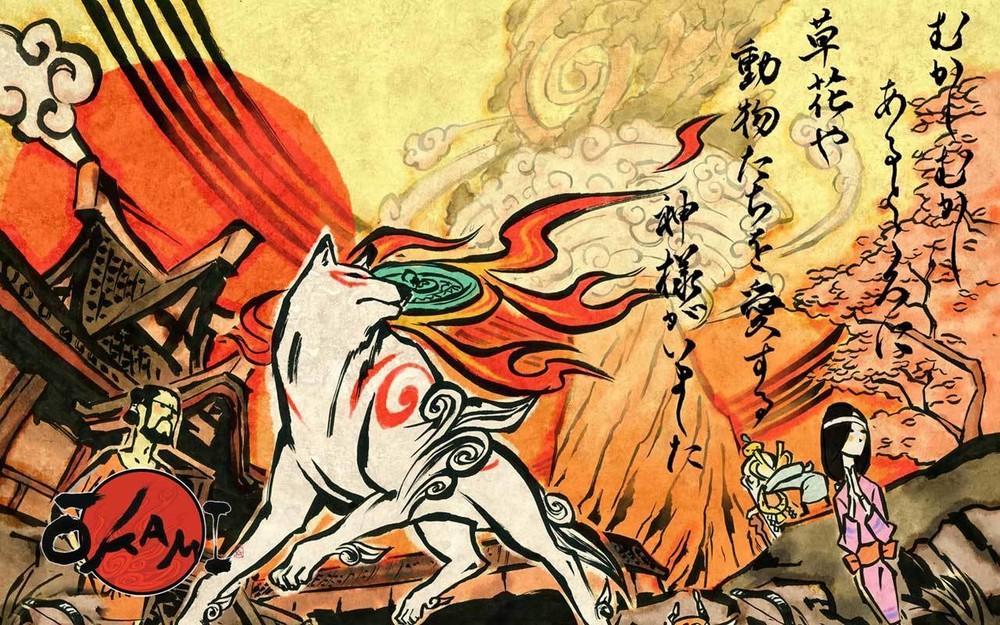
The first game I ever played to completion was Ōkami on the Wii, and it was one of the best experiences I had. It was fantastic throughout, and I enjoyed it a lot. Amaterasu the wolf god and his companion, Issun the one-inch-tall artist, brought me much emotion and fun as I roam the land of Nippon.
By the way, there will be spoilers in this article. I mean, I am discussing my favourite part of the game’s plot here. Also, this game was released in 2006, so cut me some slack.
Ōkami is one of the best games I ever played, and a big part of it was the story. It heavily references Japanese mythology, but at the same time added its own twists, so that there is still a sense of uniqueness to it.
The main plot is an amalgamation of many Japanese folktales, legends and mythologies, woven together with a few threads of Clover Studio’s own imagination into a whole. There are one tale that I will like to tell here, and a summary of the original tale it was based on as we take a look at how Clover Studios tells a tale steeped in folklore yet uniquely its own.
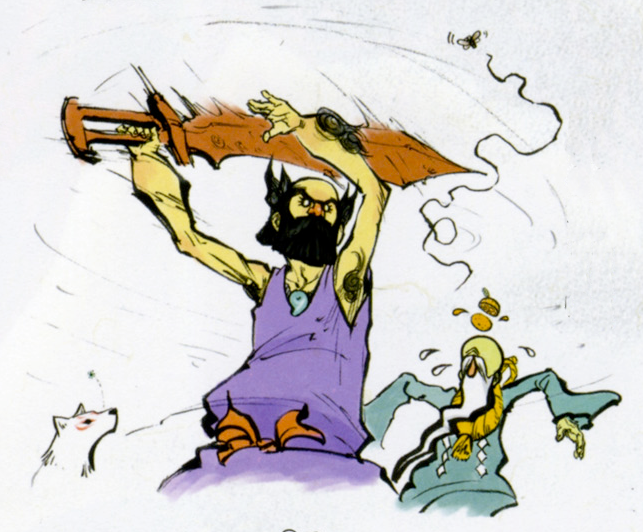
In Kamiki Village, there was a man named Susano. Supposedly the descendant of the legendary demon-sealing swordsman Nagi, he was an oaf who did nothing but to sleep, drink, boast and sloppily “practice” his swordsmanship. There is but one thing that motivates him and lift his spirits that isn’t a bottle of sake: a girl named Kushi.
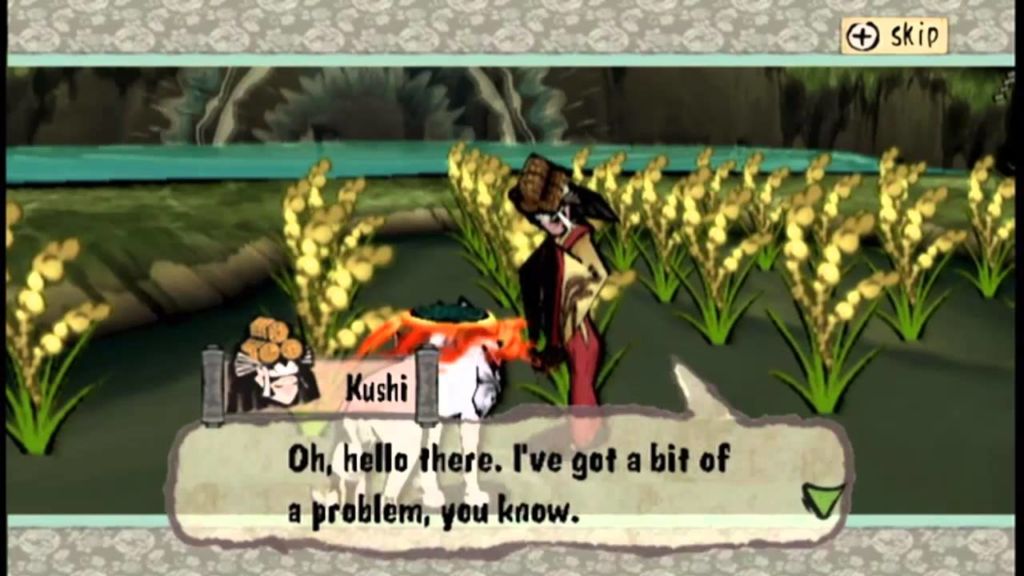
Charming, graceful and hardworking, Kushi the sake brewer is the opposite of Susano. Patient, gentle and loving, she puts up with Susano’s antics, and is well-loved by the rest of the village. Susano had the burden of his ancestor’s feat on him and struggled to cope with it, and he suffered through it while putting on a happy-go-lucky facade, with only sake and the sake brewer being his relief in this world.
One day, the deed of Nagi was undone. His sword, which served as the seal for the demon, had been removed. Orochi the eight-headed serpent, freed from his binds, spread his influence across the land, poisoning the earth and darkening the skies. Susano left the village, claiming to train and seek greater strength, but demonic interference and his own fear and weakness left him unable to achieve much.
Still, he tried, continuing to roam the land, despite constantly cowering in fear and sometimes running away at the hint of danger. He went to the Gale Shrine to pray for strength, yet it was inhabited by a powerful demon. He managed to slay it, yet he still seemed fearful as he made his way back home.
On the hundredth anniversary of the sealing of Orochi by Nagi, the annual Kamiki Festival was about to start. The 8 Purification Sake, brewed by Kushi after a lot of hard work, as well as the drink strong enough to even knock out Orochi was gone. The sake was instrumental in Nagi’s sealing of Orochi, and had a prime spot in the celebration ever since. Susano had drunk every single drop of it.
Furious and bewildered, the villagers flocked to Susano’s hut where he had shut himself in. Demanding to know why Susano had done such a deed, they crowded outside his door wanting an answer. It was then he revealed that he was the one who freed Orochi, and had drunk the sake to numb the guilt and fear of what he had done. Years and years of hearing about Nagi’s achievement and constantly being unable to match up to him had taken a toll on Susano’s mind. He went off to the Moon Cave, where Orochi once dwelt and now occupied once more, to draw Nagi’s sword free, hoping that there was no demon, his ancestor’s feat never happened, and he can be freed of these expectations. Instead, Orochi was very, very real, and he decided to made his presence felt in the village that night.
An arrow appeared out of midair at the will of Orochi. It flew across the air and struck Kushi’s roof. Orochi had spoken: Kushi is to be the next sacrifice. With the 8 Purification Sake now gone, and fearing Orochi’s wrath on the village should she failed to present herself before Orochi, Kushi put on a white kimono and brought her Thunder Brew, the strongest sake she had left, and plead for Susano to draw his own blade as she hoped that her sake is strong enough to intoxicate Orochi. She then went off on Amaterasu’s back, as Susano remained in his hut.

Once Kushi appeared before the Moon Cave, she was snatched away, her Thunder Brew fallen from a grasp into the caverns below. Amaterasu and her loyal companion Issun went below to retrieve the bottle, then ran to Kushi. Once there, they tried to get Orochi drunk with it. As strong as the Thunder Brew was, it was no 8 Purification Sake. Orochi spat it out and prepared to deal with the god and her companion so that he can enjoy his sacrifice.
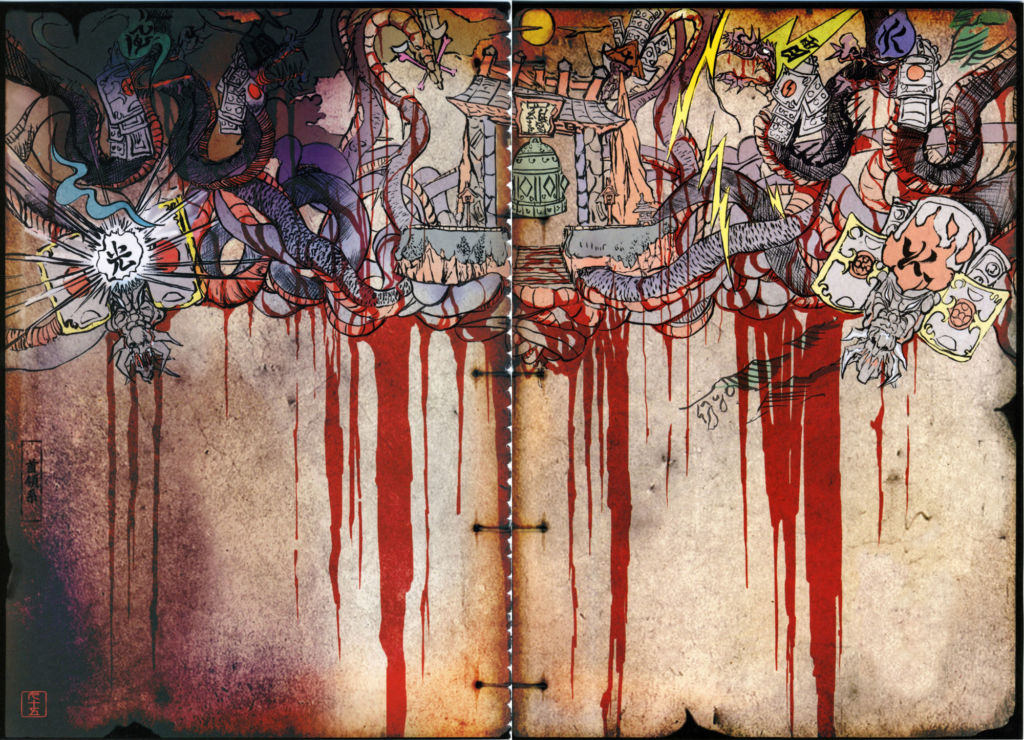
It was then a familiar purple-clad figure showed up.
Plagued by fear, wrecked with guilt, and torn with love, Susano finally brought himself to face Orochi and his own mistake. He stood his ground, and denied Orochi when he asked Susano to serve him to save his own life. His strength and his prayers brought forth a desperately needed miracle at this dark hour: a familiar brew flowed from the bottle of Thunder Brew, which was made from the waters from the same spring, rice from the same fields, and the hands of the same maiden as the 8 Purification Sake.
The powerful brew flowed across the arena, and Orochi was confronted by the 8 Purification Sake, Susano, and Amaterasu. But he was still a powerful demon, one that terrorized Nippon before Nagi sealed him. On and on they fought, until Orochi was severely weakened. With Amaterasu’s help, Susano did the unthinkable: he slayed Orochi once and for all.

With Kushi in his arms and Amaterasu by his side, Susano returned to the village as a hero, freed from his burdens at last.
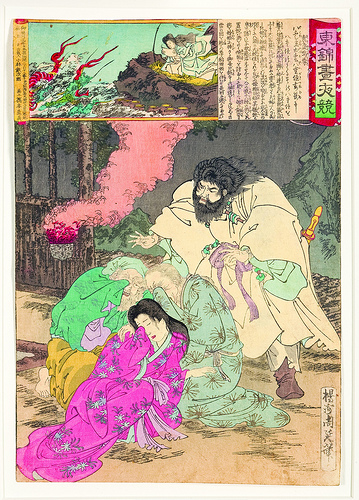
Susanoo, the god of storms, had in a fit of rage destroyed the rice fields and killed an attendant of Amaterasu, his sister as well as the goddess of the Sun. In fury and grief, Amaterasu hid in a cave, bringing with her the rays of the sun and plunging the world into darkness.
Although she was persuaded to leave the cave, Susanoo was banished from Heaven as punishment. As he roamed the mortal realm, he chanced across a family of of minor deities, an old man, his wife, and his daughter, all weeping in sorrow.
When Susanoo asked what was wrong, the old man said that the demon, Yamato-no-Orochi, was to blame. It was a giant serpent with eight heads, one body, and eight tails. They had eight daughters, and seven of them were eaten by that foul beast, until only Kushinada-hime, the young lady weeping in their embrace, was left. And now her time had come, and she was to be eaten.
Susanoo offered to slay the beast, in exchange for Kushinada’s hand in marriage. The deities accepted his offer. Susanoo turned Kushinada into a comb and stuck the comb in his hair, and instructed the old couple to build eight large gates around Orochi’s dwelling, and place a vat of eight-fold refined sake at the other side of each gate.
Orochi, smelling the wine, stuck each of his head through a gate and drank greedily from the vats, whereupon it got intoxicated by the brew and fell asleep. Susanoo swiftly began to chop off each head, then moved on to chop off each tail. When he was trying to chop off one of the tails, his sword was chipped. Curious, he split the tail open and found a great sword within. With that sword, he sought his sister’s forgiveness, and offered it as a gift.
One can easily notice the common elements between both story. Susano(o) slayed the demon Orochi and returned with Kushi(nada) as his bride. However, there is a difference, that is Susano(o)’s motivation, and his character.
Susanoo the god was powerful, and he fought in order to have Kushinada-hime as his wife. Yet Susano the mortal was very, very human. He was weak, lazy, and being hounded incessantly by a legacy that he could not hope to match. He was in pain, and the events of Ōkami unfolded due to this pain, as it drove him to unseal Orochi out of a desperate wish to escape this legacy. It backfired, and now Susano must also deal with the guilt of plunging his village into chaos and woe.
The guilt drove him to try and make amends, yet he kept failing due to his own ineptitude and Orochi’s and his minions’ interference. Finally, as the love of his live was snatched away, he faced an ultimatum: succeed, or he will never see Kushi again. And with this one last push, he finally managed to fix his mistake, gain Kushi’s heart, and finally shed the burden of his ancestor’s legacy.
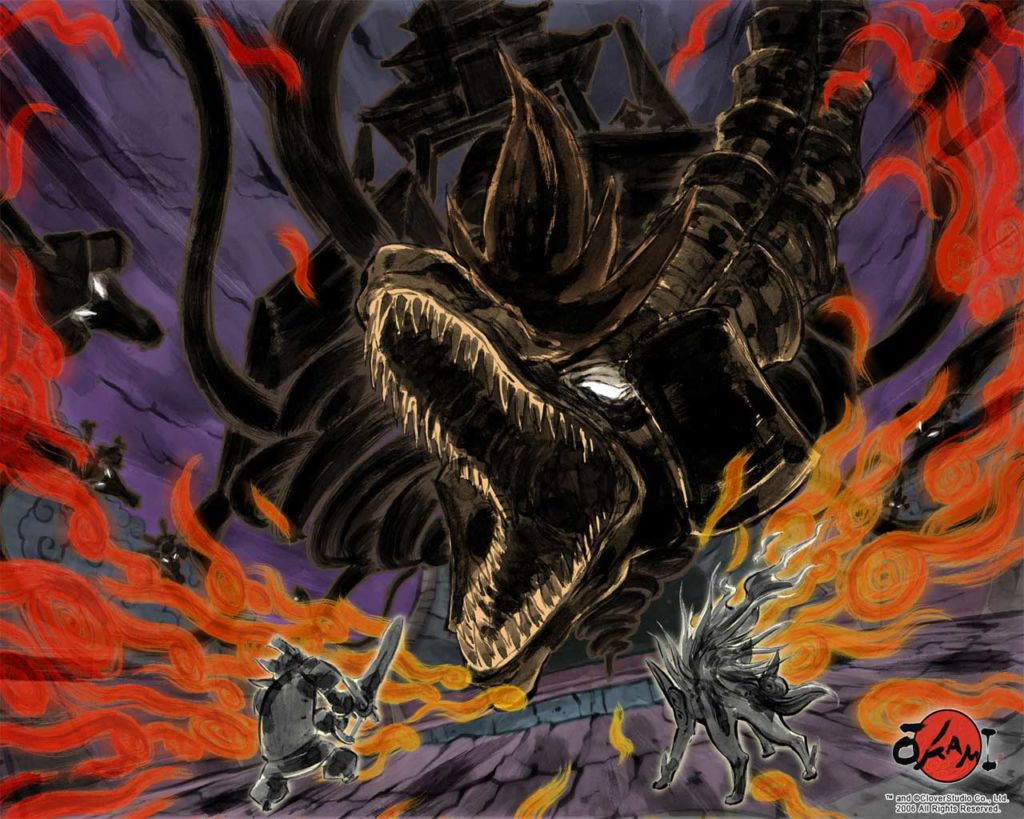
What was great about the story is how it sidestepped so many tropes to write a story driven by the characters, their actions, and their emotions. It wasn’t a classic damsel in distress story, it wasn’t a motivated by love story, and it wasn’t a plain driven by guilt story either. The first arc of Ōkami, which was the story I told above, was the story of Susano, of his growth, his pain, and him throwing himself repeatedly against what was beyond him. Amaterasu’s fight against Orochi’s force may be the main driving force of the story, but Susano is the one that starts this tale, and also the man instrumental to its end.
On its own, the story is at least decent. But when I consider the tale it was based on, I quite like how Ōkami got its first arc to follow through much of the motions of the original tale, yet managed to tell a whole new story by having a very different main character. Susano, story-wise, has as much claim to be a protagonist as Amaterasu, although gameplay-wise playing as a man who was covering in fear for about four hours before some actual fighting happens isn’t exactly my idea of fun.
The rest overall story is quite good, just that I really like the first arc the best. The second arc starts introducing to us the overarching plot, as well as having a decent mid-arc twist and possibly one of the most well-loved minor characters in the game. The third arc is rather similar to the first in the sense that it is also about a warrior overcoming his flaws and gaining redemption, but it also delves a lot more into Issun’s character and starts setting up the elements crucial to the final arc.
The final arc is essentially a boss fight gauntlet and a series of cutscenes. However, it delivers one of the best endings I have seen in video games so far. It gave me a sense of how far we’ve came, and the end was satisfying, although a bit cheesy. Just like a very well made pizza.
https://www.youtube.com/watch?v=gM6X76YMrF4
The most important part of Ōkami’s plot, I think, is that it is ultimately driven by its characters. Orochi and the big bad, Yami, may be considered forces of nature personified, but the cast, not just Amaterasu, is what drives the story forward. The tale is woven by people actively out to change their lives, some good, some bad, but none of them just passively reacting to what is happening around them. That, I suppose, is the icing on the rather well-written story that is the cake.
